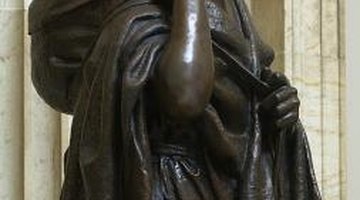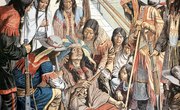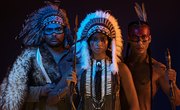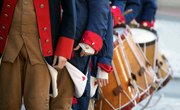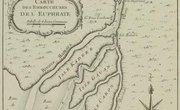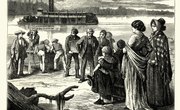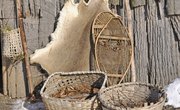The Shoshone are an American Indian tribe that have lived in the areas of Idaho, Wyoming, Utah, Nevada and California, with the highest concentration in the Snake River Valley of Idaho. Sacagawea, a Shoshone woman who served as an interpreter and guide for the Lewis and Clark expedition, is the tribe's most famous member. Several tribal chiefs are famous for leadership in conflicts against United States troops and settlers during the 19th century, including Chief Pocatello, Chief Washakie and Chief Bear Hunter.
Sacagawea
Sacagawea (c. 1788-1812) was kidnapped as a girl of 12 by the Hidsata Indians, historical enemies of the Shoshone. She was purchased by the Canadian fur-trapper Toussaint Charbonneau to be his wife near the age of 16. Lewis and Clark hired the couple as interpreters in 1804 in present-day North Dakota. Sacagawea became an important member of the expedition, brokering the purchase of horses with the Shoshone for crossing the Rocky Mountains, aiding diplomatic relations with Shoshone chiefs, and identifying edible plants. It is noteworthy that Sacagawea was young and pregnant early in the expedition, and subsequently participated in the physically demanding travel with an infant child.
Chief Pocatello
Tonaioza (c. 1815-1884), also known as Chief Pocatello, was a leader of the Western Shoshone, which ranged through Utah, Nevada and Idaho. Pocatello came to a leadership position as white settlers were arriving in traditional Shoshone lands. In 1862, bands of Shoshone under Pocatello's leadership began to attack wagon trains in southcentral Idaho. The Army retaliated, killing 350 Shoshone in the Bear River Massacre of 1863. Pocatello, recognizing the Shoshone were outmatched, joined other chiefs in signing the Treaty of Box Elder. Under terms of the treaty, the Shoshone were confined to a reduced territory, with the understanding that settlers would no longer be harassed. Most were eventually forced to relocate to the Fort Hall Reservation in Idaho.
Bear Hunter
Wirasuap (died Jan. 29, 1863), also known as Bear Hunter, was leader of a Shoshone band that lived primarily in the Cache Valley of Utah. Initial Shoshone contact with the first Mormon settlers was friendly, with Bear Hunter even meeting Brigham Young in 1847. However, as contact between white settlers and Indians increased, so did conflict, with Bear Hunter often challenging the settlers' rights to live in the Cache Valley. With the Shoshone raiding settlements and wagon trains, and at times killing settlers, the Army decided to attack Bear Hunter's camp at Bear River, resulting in the massacre of nearly the entire band, including women and children. When Bear Hunter was captured, he was stripped, beaten and whipped, and killed by a heated bayonet run through his ears.
Chief Washakie
Chief Washakie (c. 1798 to Feb. 20, 1900) was the leader of the Eastern Shoshone. While Washakie raided settlements and wagon trains during the early 1860s, his band developed a more cooperative approach with settlers as the decade progressed. In 1868, Washakie signed the Fort Bridger Treaty, which established the Wind River Reservation. Although the chief followed a more peaceful path than his western counterparts, in the end the results were not in the Shoshone interest, with the U.S. government reneging on treaty agreements, and gradually appropriating more of the land that had been granted under treaties.
Related Articles
References
Writer Bio
Scott Johnson has spent over 10 years as President of Interactive Composition Corporation, a publishing services company with offices in Portland, Oregon and New Delhi, India. Johnson's areas of expertise include business process outsourcing, international business, finance and investing. He holds a Bachelor of Arts in government from Cornell University.

